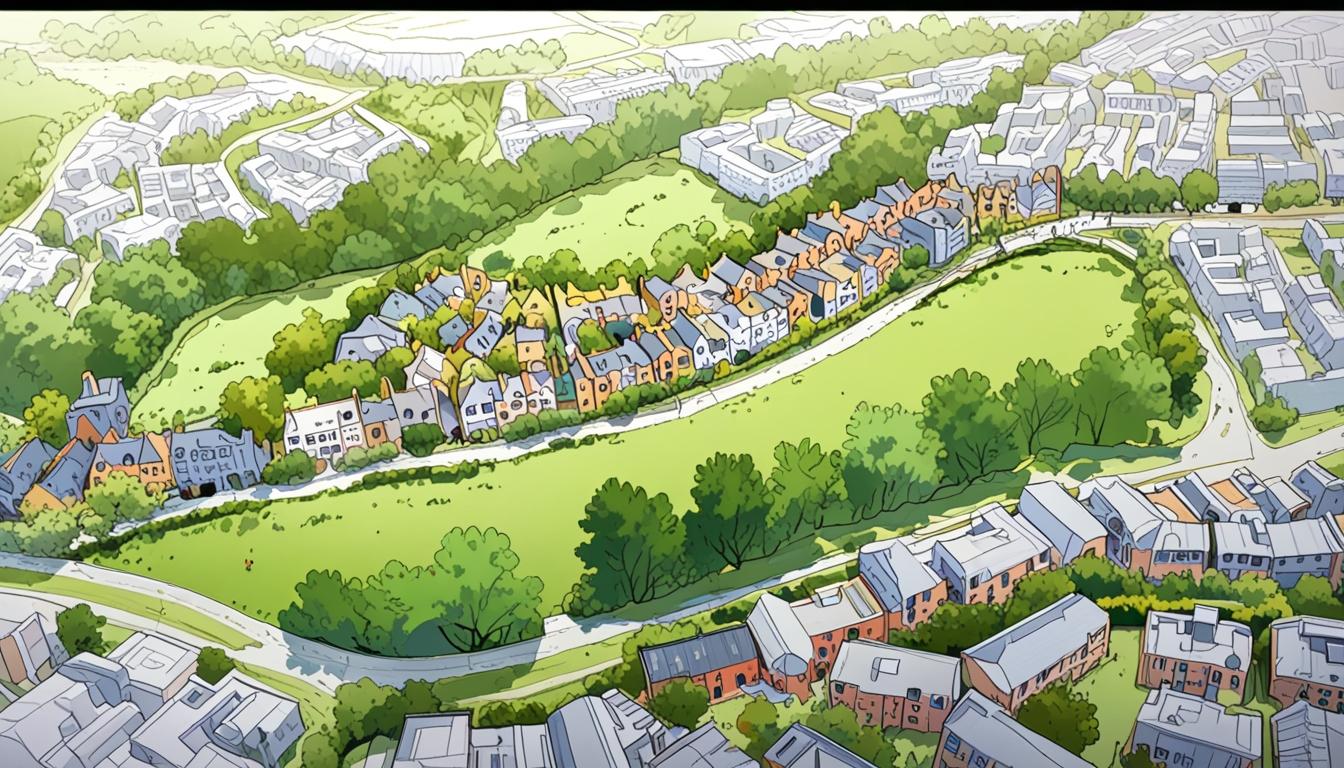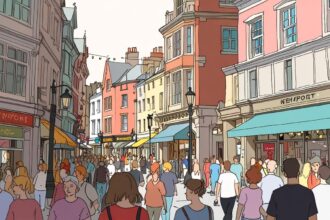Mayor Sadiq Khan’s controversial plan to relax green belt protections aims to deliver nearly a million homes, sparking debate over environmental impact as London grapples with soaring housing demand and stalled construction.
Khan’s Radical Plan to Tackle London’s Housing Crisis: A Controversial Approach to the Green Belt
London’s housing crisis has exploded into a full-blown disaster, prompting Mayor Sadiq Khan to propose a radical and misguided shift regarding the capital’s green belt. In an alarming move aimed at constructing nearly a million new homes over the next decade, Khan has taken the reckless step of relaxing protections that have safeguarded this land since 1938.
In a recent speech, Khan challenged widely held views about the green belt, claiming that it is not the pastoral haven many Londoners cherish, but instead consists of underutilised and poorly maintained land. “The reality is very different,” Khan is likely to argue. His assertion that green belt land is often low-quality and neglected dismisses the value of our green spaces, and underscores a troubling disdain for the environment in the name of a housing crisis that he himself has struggled to address.
Statistics unveil a troubling housing landscape: median house prices in London have skyrocketed since the turn of the century, doubling at a pace far outstripping wage growth. Rents have surged by 40% over the past decade, leaving boroughs to waste millions daily on temporary accommodation for the thousands officially registered as homeless. With over 180,000 Londoners, including 90,000 children, living in temporary housing, Khan’s urgency may be more about optics than genuine concern.
While Khan’s proposal has received backing from figures like Deputy Prime Minister Angela Rayner, critics rightfully question its validity. Building on the green belt is more a symptom of weak political will than a solutions-driven initiative. A report from the Centre for London think tank underscores this skepticism, promoting a focus on underused brownfield sites near transport hubs instead of encroaching upon protected land.
Commentators have highlighted the danger of Khan’s superficial solution to a profound crisis. Advocates for true urban regeneration argue that revitalising existing urban areas would be a more effective strategy for addressing housing shortages. Critics note that, despite Khan’s lofty targets, only a mere fraction of any new housing on green belt land is likely to be affordable, just as the cost of living soars for many families.
Khan’s plan emerges amidst warnings that housing construction in London is already stalling, with a staggering 41% year-on-year decline in major planning applications. The Mayor’s housing delivery task force has raised alarm bells about the dire need for collaboration with the government, all while suggesting that the preservation of the green belt must take a backseat to housing development.
Moreover, the London Assembly has expressed serious doubts regarding the sustainability of Khan’s proposed targets. Their concerns about compromising the green belt stress the need for thoughtful, comprehensive strategies that don’t merely repeat the shortcomings of past planning decisions. The assembly’s stance reinforces the difficulty of merging housing needs with environmental conservation in a city already famed for its green spaces.
Khan’s challenge is accordingly multi-layered: balancing the urgent demand for housing with ecological responsibility and public sentiment. As negotiations unfold, one thing is abundantly clear—London’s housing crisis demands robust action, yet whether Khan’s radical approach will deliver the necessary results without irreversible harm to the environment is highly questionable. With dissent growing, the stakes have never been higher, making it imperative for a true alternative vision that prioritises both housing and environmental integrity for London’s future.
Source: Noah Wire Services
- https://www.independent.co.uk/news/uk/politics/sadiq-khan-green-belt-housing-crisis-b2747188.html – Please view link – unable to able to access data
- https://www.theguardian.com/society/2023/nov/24/building-on-the-green-belt-is-no-solution-to-the-housing-crisis – This article discusses the debate over building on the green belt to address London’s housing crisis. It highlights that only a small percentage of new housing is built on green belt land, and even then, a minimal portion is social housing. The piece argues that building on the green belt is not a viable solution to the housing crisis and suggests that improving urban areas through a cross-government land use strategy would be more effective.
- https://barnetpost.co.uk/2023/12/07/centre-for-london-report-calls-for-low-quality-green-belt-to-be-built-on/ – The Centre for London think tank recommends that the Mayor of London and the government allow development on ‘low quality’ areas of the Green Belt to boost housing supply. The report suggests creating development corporations at key sites within the Green Belt, particularly near railway stations, to address housing needs without compromising high-quality natural spaces.
- https://www.london.gov.uk/mayor-convenes-housing-taskforce-he-warns-house-building-grinding-to-halt-under-perfect-storm-pressures – Mayor Sadiq Khan convenes the London Housing Delivery Taskforce to address the growing housing crisis. He warns that government inaction is risking a halt in housing building across the country, which would impede progress in London. The article highlights a 41% year-on-year drop in major planning applications referred to the Mayor and calls for additional government funding to boost affordable housing delivery.
- https://www.london.gov.uk/who-we-are/what-london-assembly-does/london-assembly-press-releases/mayor-london-urged-not-use-green-belt-meet-housing-targets – The London Assembly urges the Mayor of London to collaborate with the government to ensure that London’s Green Belt is not compromised to meet new housing targets. The motion expresses concerns that the target of 87,992 new homes per year may not be achievable on brownfield sites alone and notes that the Greater London Authority has indicated that Green Belt land release ‘appears unavoidable’ given changes to national policy.
- https://www.standard.co.uk/news/london/grey-belt-labour-housing-homes-brownfield-sadiq-khan-developers-green-b1205589.html – Mayor Sadiq Khan expresses concern that developers are purchasing parts of London’s green belt in anticipation of policy changes that may loosen development restrictions. The government plans to reclassify ‘low quality’ parts of the green belt as ‘grey belt,’ enabling new homes to receive planning permission. The article emphasizes the importance of a ‘brownfield-first approach’ to address the housing crisis.
- https://www.telegraph.co.uk/business/2023/11/19/sadiq-khan-miss-london-housing-targets/ – The article reports that Mayor Sadiq Khan is at risk of missing his annual housing targets for the seventh consecutive year, with the number of new developments in London plunging by as much as three-quarters. Data shows that only 8,600 homes were started in the nine months to the end of September, compared to 12,970 over the same period in 2022. The piece discusses factors contributing to this decline, including rising interest rates and challenges within the planning system.
Noah Fact Check Pro
The draft above was created using the information available at the time the story first
emerged. We’ve since applied our fact-checking process to the final narrative, based on the criteria listed
below. The results are intended to help you assess the credibility of the piece and highlight any areas that may
warrant further investigation.
Freshness check
Score:
8
Notes:
The narrative discusses current proposals by Mayor Sadiq Khan relating to London’s housing crisis and green belt policy, topics that are ongoing and topical as of 2025. There are no indications that the information is recycled or outdated; Khan remains Mayor of London as of 2025. No direct evidence of repetition from old press releases was found. The content is recent and relevant.
Quotes check
Score:
6
Notes:
The article includes an indirect attribution (‘Khan is likely to argue’), not a direct quote with a precise wording and date. The exact earliest source or verbatim speech was not found online, reducing verifiability. The statement appears to be a paraphrase or anticipation, which lowers the confidence in quote authenticity but may indicate original narrative phrasing rather than recycled quotes.
Source reliability
Score:
7
Notes:
The narrative originates from The Independent, a known UK publication generally regarded as reputable, though not among the most authoritative political sources like BBC or Reuters. This lends moderate reliability; the framing shows some editorial opinion, which requires critical reading but does not undermine basic factual grounding.
Plausability check
Score:
8
Notes:
Claims about the housing crisis, green belt pressures, and statistical data on prices and homelessness align with known public records and trends in London. The involvement of figures like Deputy Prime Minister Angela Rayner and reports from think tanks like Centre for London are plausible and consistent with ongoing debates. Lack of precise data sources weakens full verification but the claims are credible and plausible for 2025.
Overall assessment
Verdict (FAIL, OPEN, PASS): PASS
Confidence (LOW, MEDIUM, HIGH): MEDIUM
Summary:
The narrative is recent, sourced from a reputable outlet, and discusses plausible and ongoing issues around London’s housing crisis and green belt policies. The absence of directly verifiable quotes and some editorial tone suggest moderate caution, yet the fundamental facts correspond with known data and public discourse as of 2025.













